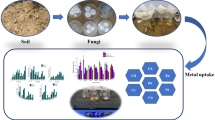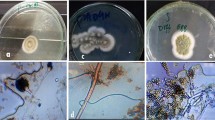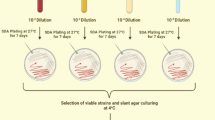Abstract
Microorganisms play an important role in the bioremediation of heavy metal-contaminated wastewater and soil. In this research, isolation of heavy metal-resistant fungi was carried out from wastewater-treated soil samples of Hudiara drain, Lahore. The purpose of the present investigation was to observe fungal absorption behavior toward heavy metal. The optimum pH and temperature conditions for heavy metal removal were determined for highly tolerant isolates of Aspergillus spp. along with the initial metal concentration and contact time. Biosorption capacity of A. flavus and A. niger was checked against Cu(II) and Pb(II), respectively. The optimal pH was 8–9 for A. flavus and 4–5.4 for A. niger, whereas optimal temperature was 26 and 37 °C, respectively. Moreover, the biosorption capacity of A. flavus was 20.75–93.65 mg g−1 for Cu(II) with initial concentration 200–1400 ppm. On the other hand, biosorption capacity of A. niger for Pb(II) ranged from 3.25 to 172.25 mg g−1 with the same range of initial metal concentration. It was also found that equilibrium was maintained after maximum adsorption. The adsorption data were then fitted to Langmuir model with a coefficient of determination >0.90. The knowledge of the present study will be helpful for further research on the bioremediation of polluted soil.
Similar content being viewed by others
References
Parameswari E., Lakshmanan A., Thilagavathi T.: Biosorption and metal tolerance potential of filamentous fungi isolated from metal polluted ecosystem. Electron. J. Environ. Agric. Food Chem. 9(4), 664–671 (2010)
Zhang G.L., Yang F.G., Zhao Y.G., Zhao W.J., Yang J.L., Gong Z.T.: Historical change of heavy metals in urban soils of Nanjing, China during the past 20 centuries. Environ. Int. 31(6), 913–919 (2005)
Suciu I., Cosma C., Todică M., Bolboacă S.D., Jantschi L.: Analysis of soil heavy metal pollution and pattern in central Transylvania. Int. J. Mol. Sci. 9, 434–453 (2008)
Selen V., Ozer D., Ozer A.: A study on the removal of Cr(VI) ions by Sesame (Sesamum indicum) stems dehydrated with Sulfuric Acid. Arab. J. Sci. Eng. 39(8), 5895–5904 (2014)
Pena-Castro J.M., Martnezjeronimo F., Esparza-Garca F., Canizares-Villanueva R.O.: Heavy metals removal by the microalga Scenedesmus incrassatulus in continuous cultures. Bioresour. Technol. 94, 219–222 (2004)
Munoz R., Alvarez M.T., Munoz A., Terrazas E., Guieysse B., Mattisasson B.: Sequential removal of heavy metals ions and organic pollutants using an algal-bacterial consortium. Chemosphere 63, 903–991 (2006)
Borah D., Yadav R.N.S.: Biodegradation of diesel, crude oil, kerosene and used engine oil by a newly isolated Bacillus cereus strain DRDU1 from an automobile engine in liquid culture. Arab. J. Sci. Eng. 39(7), 5337–5345 (2014)
Edris G., Alhamed Y., Alzahrani A.: Biosorption of Cadmium and Lead from aqueous solutions by Chlorella vulgaris biomass: equilibrium and kinetic study. Arab. J. Sci. Eng. 39(1), 87–93 (2013)
Yan G., Viraraghavan T.: Heavy metal removal from aqueous solution by fungus Mucor rouxii. Water Res. 37, 4486–4496 (2003)
Mannan K.A., Fakhru’l-Razi M.D., Alam Z.: Use of fungi to improve bioconversion of activated sludge. Water Res. 39(13), 2935–2943 (2005)
Zafar S., Aqil F., Ahmad I.: Metal tolerance and biosorption potential of filamentous fungi isolated from metal contaminated agricultural soil. Bioresour. Technol. 98, 2557–2561 (2006)
Iram S., Basharat K., Ahmad I.: Tolerable analysis of the fungi of the Peri-Urban agricultural area. Pak. J. Bot. 45(S1), 475–480 (2013)
Congeevaram S., Dhanarani S., Park J., Dexilin M., Thamaraiselvi K.: Biosorption of chromium and nickel by heavy metal resistant fungal and bacterial isolates. J. Hazard. Mater. 146, 270–277 (2007)
Javaid A., Bajwa R., Javaid A.: Biosorption of heavy metals using a dead macro fungus schizophyllum commune fries: evaluation of equilibrium and kinetic models. Pak. J. Bot. 42(3), 2105–2118 (2010)
Hasan S., Hashim M.A., Gupta B.S.: Adsorption of Ni(SO4) on Malaysian rubber–wood ash. Bioresour. Technol. 72, 153–158 (2000)
Fourest E., Volesky B.: Alginate properties and heavy metal biosorption by seaweed biomass. Biotechnol. Appl. Biochem. 67, 215–226 (1997)
Chergui A., Bakhti M.Z., Chahboub A., Haddoum S., Selatnia A., Junter G.A.: Simultaneous biosorption of Cu2+, Zn2+ and Cr6+ from aqueous solution by Streptomyces rimosus biomass. Desalination 206, 179–184 (2007)
Beveridge T.G.: The immobilization of soluble metals by bacterial walls. Biotechnol. Bioeng. 16, 127–140 (1986)
Gulay B., Sema B., Yakup A.M.: Biosorption of heavy metal ions on immobilized white-rot fungus Trametes versicolor. J. Hazard. Mater. B 101, 285–300 (2003)
Goyal N., Banerjee U.C.: Comparative studies on the microbial adsorption of heavy metals. Adv. Environ. Res. 7, 311–319 (2003)
Saglam A., Yalcinkaya Y., Denizli A., Arica M.Y., Gene O., Bektas S.: Biosorption of mercury by carboxy methylcellulose and immobilized Phanerochaete chrysosporium. Microchem. J. 71, 73–81 (2002)
Chatterjee S.K., Bhattacharjee I., Chandra G.: Biosorption of heavy metals from industrial waste water by Geobacillus thermodenitrificans. J. Hazard. Mater. 175, 117–125 (2010)
Huang C.P., Huang C.P., Morehart A.: The removal of Cu(II) from dilute aqueous solutions by Saccharomyces cerevisiae. Water Res. 4, 433–439 (1990)
Veit M.T., Tavares R.G., Gomes-da-Costa S.M., Guedes T.A.: Adsorption isotherms of copper(II) for two species of dead fungi biomass. Process Biochem. 40, 3303–3308 (2005)
Sheng P.X., Ting J.P.: Biosorption of heavy metal ions (Pb, Cu and Cd) from aqueous solution by the Marine Alga Sargassum sp., in single and multiple metal systems. Ind. Eng. Chem. Res. 46, 2438–2444 (2007)
Pakshirajan K., Swaminathan T.: Biosorption of lead, copper and cadmium by Phanerochaete chrysosporium in ternary metal mixtures: statistical analysis of individual and interaction effects. Appl. Biochem. Biotechnol. 158(2), 457–469 (2009)
Mukhopadhyay M., Noronha S.B., Suraishkumar G.K.: Kinetic modeling for the biosorption of copper by pretreated Aspergillus niger biomass. Bioresour. Technol. 98, 1781–1787 (2007)
Langmuir I.: The constitution and fundamental properties of solids and liquids, part. I: solids. J. Am. Chem. Soc. 38, 2221–2295 (1916)
Kratochvil D., Volesky B.: Advances in biosorption of heavy metals. Trends Biotechnol. 161, 291–300 (1998)
Sa Y., Akçael B., Kutsal T.: Ternary biosorption equilibria of chromium(VI), copper(II), and cadmium(II) on Rhizopus arrhizus. Sep. Sci. Technol. 37(2), 279–309 (2002)
Shugaba A., Nok A.J., Ameh D.A., Lori A.: Studies on the growth of some filamentous fungi in culture solutions containing hexavalent chromium. Int. J. Biotechnol. Biochem. 6(1), 715–722 (2010)
Wang J., Chen C.: Biosorbents for heavy metals removal and their future. Biotechnol. Adv. 27, 195–226 (2009)
Iram S., Zaman A., Iqbal Z., Shabbir R.: Heavy metal tolerance of fungus isolated from the soil contaminated with sewage and industrial wastewater. Pol. J. Environ. Stud. 22(3), 691–697 (2013)
Iram S., Perveen K., Shuja N., Waqar K., Akhtar I., Ahmad I.: Tolerance potential of different species of Aspergillus as bioremediation tool-comparative analysis. J. Biodivers. Environ. Sci. 3(4), 1–10 (2012)
Author information
Authors and Affiliations
Corresponding author
Rights and permissions
About this article
Cite this article
Iram, S., Shabbir, R., Zafar, H. et al. Biosorption and Bioaccumulation of Copper and Lead by Heavy Metal-Resistant Fungal Isolates. Arab J Sci Eng 40, 1867–1873 (2015). https://doi.org/10.1007/s13369-015-1702-1
Received:
Accepted:
Published:
Issue Date:
DOI: https://doi.org/10.1007/s13369-015-1702-1




